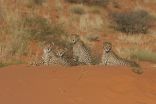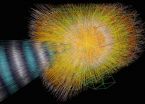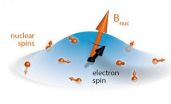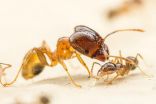New study suggests humans to blame for plummeting numbers of cheetahs
2014-10-02
(Press-News.org) A new study led by Queen's University Belfast into how cheetahs burn energy suggests that human activity, rather than larger predators, may force them to expend more energy and thus be the major cause of their decline.
Wild cheetahs are down to under 10,000 from 100,000 a century ago with conventional wisdom blaming bigger predators for monopolising available food as their habitat becomes restricted. The traditional thinking has been that cheetahs no longer have sufficient access to prey to fuel their enormous energy output when engaging in super-fast chases.
But, in the first study of its kind, published today in the international journal Science, academics from Queen's, other Universities and conservation institutions have made the surprising discovery that, in the main, cheetahs do not use significantly more energy than other, similar-sized mammals.
The scientists also discovered that, in searching for prey, cheetahs incur more energy loss than in outbursts of running which, although spectacular, are infrequent. So, where their prey have been reduced or re-distributed through human impacts, their ability to balance energy budgets has been severely curtailed.
Lead researcher Dr Michael Scantlebury from Queen's School of Biological Sciences said: "We studied 19 free-roaming cheetahs each for two weeks across two sites in southern Africa, one in the Kalahari desert and the other in a wetter area. We injected heavy water into the animals before tracking them continuously and collecting their faeces. From these samples, we could determine how much of this heavy water they were losing each day and calculate their energy expenditures.
"What we found was that the cats' energy expenditure was not significantly different from other mammals of similar size – cheetahs may be Ferraris but most of the time they are driving slowly. What our study showed was that their major energy costs seem to be incurred by travelling, rather than securing prey. If you can imagine walking up and down sand dunes in high temperatures day in, day out, with no water to drink you start to get a feel for how challenging these cats' daily lives are, and yet they remain remarkably adapted and resilient.
"They can even withstand other species, such as lions and hyenas, stealing their prey. The reality may be that human activities – for example erecting fences that inhibit free travel or over-hunting cheetah prey – are forcing cheetahs to travel ever-increasing distances and that this may be compromising their energy more than any other single factor. Our study, which is the result of ten years' of research, seriously questions previously held assumptions about the factors affecting population viability in large predators threatened by extinction."
Co-researcher Dr Nikki Marks, also from Queen's University Belfast said: "Research of this type helps improve our understanding of the challenges facing cheetahs as they strive to survive and helps inform future decisions on conservation strategies for cheetahs and other threatened animals."
Manuscript co-author Dr John Wilson of North Carolina State University said: "Too often we blame lions and hyenas for decimating cheetah populations when in fact, it is likely to be us humans that drive their declines. Imagine how hard it must be for a small cub to follow its mother further and further through the desert to look for food, while she herself is fighting for survival."
Another key member of the research team, Dr Gus Mills from The Lewis Foundation said: "Having spent the best part of six years studying these animals in the Kalahari you get a good understanding at first hand of the challenges they face in order to survive, even without the detrimental impact of human activity."
INFORMATION:
The Queen's-led research was carried out in partnership with Oxford University, Swansea University, Ohio State University, North Carolina State University, the University of Aberdeen, the University of Pretoria, the Chinese Academy of Sciences, The Lewis Foundation (South Africa), the South African Wildlife Research Expedition and the Zoological Society of London. It was supported by awards from the Natural Environment Research Council (NERC) and the Royal Society.
For more information contact Queen's Communications Officers Una Bradley (Mon-Wed) on 0044 (0)28 9097 5320 or Michelle Cassidy (Thurs-Fri) on 0044 (0)28 9097 5310 or email comms.officer@qub.ac.uk
Reporters wishing to link to this paper's abstract on sciencemag.org can do so by clicking http://www.sciencemag.org/lookup/doi/10.1126/science.1256424
Dr. Michael Scantlebury is available for interview. Bids to Queen's Communications Officers Una Bradley (Mon-Wed) on 0044 (0)28 9097 5320 or Michelle Cassidy (Thurs-Fri) on 0044 (0)28 9097 5310 or email comms.officer@qub.ac.uk
Pictures to go with this release are available from Queen's Communications Officers Una Bradley (Mon-Wed) on 0044 (0)28 9097 5320 or Michelle Cassidy (Thurs-Fri) on 0044 (0)28 9097 5310 or email comms.officer@qub.ac.uk
Extra quotes from manuscript co-authors available below:
Co-researcher on the project Dr Sarah Durant, from the Zoological Society of London, said: "Most of the world's remaining cheetahs survive outside of protected areas where human populations are increasing. Our results show that as cheetahs are compelled to travel across larger distances in order to find prey while avoiding people, they are likely to face increasing pressures on their energy budgets that may have serious impacts on their chance of survival."
Manuscript co-author Professor John R Speakman from the University of Aberdeen said: "Cheetah populations have declined enormously. Food stealing by lions and hyenas has been widely regarded as a key problem, but this landmark study suggests that cheetahs are not troubled by this problem – pointing to human disturbance as the main issue."
Co-author Professor Rory Wilson said: "I guess if you talk to the world's greatest sprinters, they too will tell you they spend more energy walking around town than thundering up the track. Funny that we never thought of it for cheetahs."
[Attachments] See images for this press release:

ELSE PRESS RELEASES FROM THIS DATE:
2014-10-02
CAMBRIDGE, MA -- Yeast are commonly used to transform corn and other plant materials into biofuels such as ethanol. However, large concentrations of ethanol can be toxic to yeast, which has limited the production capacity of many yeast strains used in industry.
"Toxicity is probably the single most important problem in cost-effective biofuels production," says Gregory Stephanopoulos, the Willard Henry Dow Professor of Chemical Engineering at MIT.
Now Stephanopoulos and colleagues at MIT and the Whitehead Institute for Biomedical Research have identified a new way to ...
2014-10-02
How can we tell when someone has fallen asleep? To answer this question, scientists at Massachusetts General Hospital have developed a new statistical method and behavioural task to track the dynamic process of falling asleep.
Dr Michael Prerau, Dr Patrick Purdon, and their colleagues used the evolution of brain activity, behaviour, and other physiological signals during the sleep onset process to automatically track the continuous changes in wakefulness experienced as a subject falls asleep.
The study, publishing today in PLOS Computational Biology, suggests that it ...
2014-10-02
VIDEO:
Dr. Frans Leenen, from the University of Ottawa Heart Institute, discusses the importance of these new findings.
Click here for more information.
Ottawa, ON and Baltimore, MD, October 2, 2014—New research by scientists at the Ottawa Heart Institute and the University of Maryland School of Medicine (UM SOM) has uncovered a new pathway by which the brain uses an unusual steroid to control blood pressure. The study, which also suggests new approaches for treating high blood ...
2014-10-02
Biologists from the University of York have compiled two new datasets on insect evolution, revealing that metamorphosing insects diversify more quickly than other insects and are therefore the biggest contributors to the evolution of insect diversity.
Both funded by the Natural Environment Research Council (NERC), the first dataset is a complete fossil catalogue showing timescales of origination and extinction of different families of insects. Working with the Natural History Museum and National Museums Scotland, former PhD student Dr David Nicholson collated a database ...
2014-10-02
By combining data from two high-energy accelerators, nuclear scientists have refined the measurement of a remarkable property of exotic matter known as quark-gluon plasma. The findings reveal new aspects of the ultra-hot, "perfect fluid" that give clues to the state of the young universe just microseconds after the big bang.
The multi-institutional team known as the JET Collaboration, led by researchers at the U.S. Department of Energy's Lawrence Berkeley National Lab (Berkeley Lab), published their results in a recent issue of Physical Review C. The JET Collaboration ...
2014-10-02
As the Supreme Court of the United States begins its fall 2014 session this month, it faces decisions on several "blockbuster" cases, including freedom of speech, religious freedoms in prison, pregnancy discrimination and a possible decision on gay marriage.
Just don't expect any of these decisions until next June, just before the court's session ends.
New research from the Washington University in St. Louis School of Law finds big, or "blockbuster," cases are disproportionately decided at the end of June, just before the court's summer recess.
"We knew that more than ...
2014-10-02
Older parents, birth defects, maternal nutrition and childhood exposure to CT scans and pesticides are increasingly being associated with brain tumors in children, according to new research from the Brown School at Washington University in St. Louis.
Brain and central nervous system tumors are the second leading cause of cancer death in children.
A team of researchers, led by Kimberly Johnson, PhD, assistant professor of social work at the Brown School, a member of the Institute for Public Health and a research member of Siteman Cancer Center, examined studies published ...
2014-10-02
Where are the quantum computers? Aren't they supposed to be speeding up decryption and internet searches? After two decades of research, you still can't find them in stores. Well, it took two decades or more of research dedicated to semiconductors and circuit integration before we had digital computers. For quantum computers too it will take technology more time to catch up to the science
Meanwhile, research devoted to exploring bizarre quantum phenomena must continue to overcome or reduce a litany of practical obstacles before quantum computing can be realized. ...
2014-10-02
Montréal, October 2, 2014 – Scientists at the IRCM discovered a mechanism that promotes the progression of medulloblastoma, the most common brain tumour found in children. The team, led by Frédéric Charron, PhD, found that a protein known as Sonic Hedgehog induces DNA damage, which causes the cancer to develop. This important breakthrough will be published in the October 13 issue of the prestigious scientific journal Developmental Cell. The editors also selected the article to be featured on the journal's cover.
Sonic Hedgehog belongs to a family of proteins that gives ...
2014-10-02
CHAMPAIGN, Ill. — The big-headed ant (Pheidole megacephala) is considered one of the world's worst invasive ant species. As the name implies, its colonies include soldier ants with disproportionately large heads. Their giant, muscle-bound noggins power their biting parts, the mandibles, which they use to attack other ants and cut up prey. In a new study, researchers report that big-headed ant colonies produce larger soldiers when they encounter other ants that know how to fight back.
The new findings appear in the Biological Journal of the Linnean Society.
Big-headed ...
LAST 30 PRESS RELEASES:
[Press-News.org] New study suggests humans to blame for plummeting numbers of cheetahs





